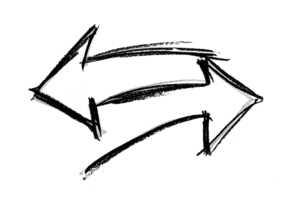If you’ve heard it a thousand times, here’s one more. Content is king in Search Engine Optimization. It makes sense overall, as you are looking to rank on Google for specific keywords. Google must, in some form or fashion, utilize metrics for ranking signals when looking to decide which page should show up on a search engine results page. While technical SEO and links are both factors, the most immediate factor is going to be the words on the page itself. These specific ranking signals are the same across the board and you can utilize our checklist guide to optimizing a blog should you be looking for a quick breakdown of blog optimization. We understand the struggle of knowing how to optimize your blogs and the pages on your site. Here are a few indicators that can give you an idea if you are on the right track to optimizing your blogs and page content.
ON-PAGE VS. BLOG CONTENT: WHAT’S THE DIFFERENCE?
While the content which lives on your website is all displayed with HTML and has all of the regular optimization items discussed in our checklist, it is important to understand the difference in targeting, optimization, and expectations between these two types of pages. On-page content is described as the “Core” pages of your website. These are pages like your home page, services page(s), contact page, and so on. Blog content is content which will live in a different area of your website and should support those “core” pages as listed above.
In the case of our website, our Denver SEO page has gone through on-page optimization as it is a core page. One of the blogs we have posted, such as What Does an SEO Company Do? is optimized a little differently and the expectations for rankings, traffic, and conversions vary from its “on-page” counterpart. In a concise explanation, pages in need of “on-page” optimization are intended to drive relevant, convertible traffic to your website and blogs are used to support those pages with more broad keywords and a wealth of links pointing to similar and relevant articles and pages on the site. Now that you’ve got a grasp of the difference, it is time to dig into optimization.

SIMILARITIES IN OPTIMIZATION
Many of the direct aspects of optimization remain the same. You should choose a target keyword you’ve never targeted on another page within the website. You should implement meta titles and descriptions, structure HTML headers properly. Make sure there is an image in the text to both break up the text for the reader and send Google another ranking signal in the form of alt text. All of these items should have your keyword input appropriately, and secondary target keywords input where they should be as well. Once we have the basics of optimization implemented, the differences become more apparent in the approach and revisions of blogs and pages found on the site.

DIFFERENCES IN OPTIMIZATION
While the core optimization tasks are all the same, the differences lie in the expectations and types of keywords you’d like to rank. Our Denver SEO page, referenced above, targets a keyword with a high potential conversion rate. While this page may target Denver SEO, a blog page may target “SEO” or “Search Engine Optimization”. Instead of trying to segment our readers to the Denver area, we are applying to a national audience who is more interested in general SEO information rather than a city-based service. It is this difference that is imperative to understanding the change in approach to optimization between these two pieces of content on your site.
We typically don’t go back through and “reoptimize” a blog after it’s been posted unless we are looking to refresh the content. Blogs stay as they were originally posted in most regards and are used to funnel SEO value and traffic upward to your most important pages. We do this by interlinking. If we are writing about SEO, we would want to link to the Denver SEO page at least one time since the content supports the content found on the Denver SEO page.
We do go back and rehash the content found on the “core” pages of a website as mentioned above. It is important to continuously update these pages, as Google likes seeing updates and even though recrawling the site uses up more of Google’s resources, you are creating demand for your content by posting and revising it. Google wants to make sure they are supplying your regular readers with up to date content and will keep coming back with the more changes you make to your website. If our intention for blogs is to support top-level content, top-level content must be designed to convert and the keywords must follow suit as discussed above. Now, say I was monitoring our rankings for the “Denver SEO” keyword and it fizzled out around position 13 (just off the first page). I would need to take a step back and look at what I could optimize to try to push this page up. This is where the majority of the differences in optimization come into the light. On-page content can always use a little TLC, and understanding where to focus your time can keep you from spinning tires and going nowhere. There are a few metrics to consider and implement when you are looking to outrank another competitor. Here at Firestarter, we audit the websites ranking ahead of us and make an attempt to beat out those metrics in the areas we can control. Some of the key metrics we focus on are:
- Word Count
- Links
- Headers
- Keyword Density
- Images
- Site/Page Speed
If you are able to add more words to the page than your competition, this gives you a leg up. If you are able to generate more relevant links to the specific page than your competition, you have a better chance to beat them out. If you utilize your target keyword in headers and throughout the copy better than the competition, you have better potential to outrank them. If your site is faster than your competitors, the real estate on the first SERP is within reach.
Now, imagine yourself beating your competition in all of these factors! You’d be all over the first page and solidifying your place by continuing to revise as new competition enters the space.
Feel free to contact us should you have any questions or want to talk shop! We love hearing from our readers and hope you enjoyed this article outlining the difference in on-page and blog optimization.


